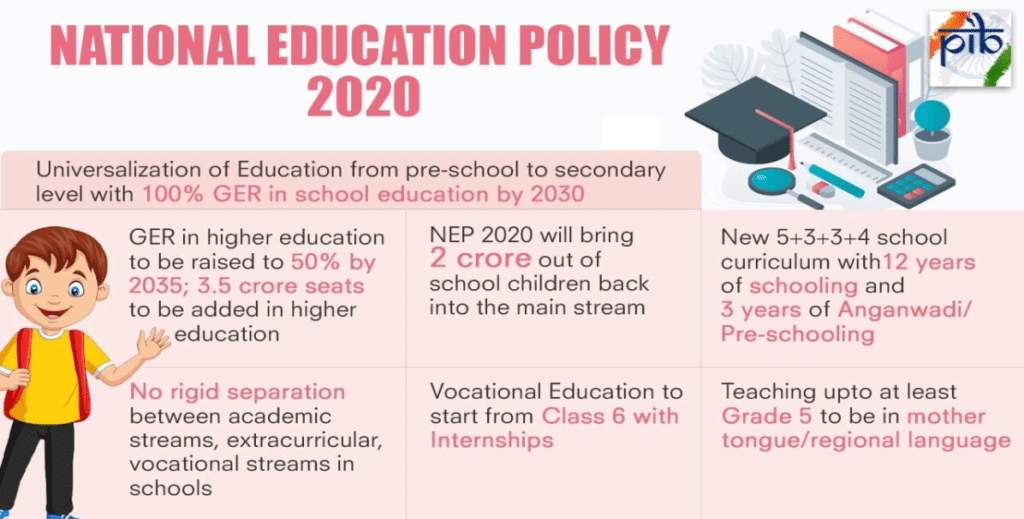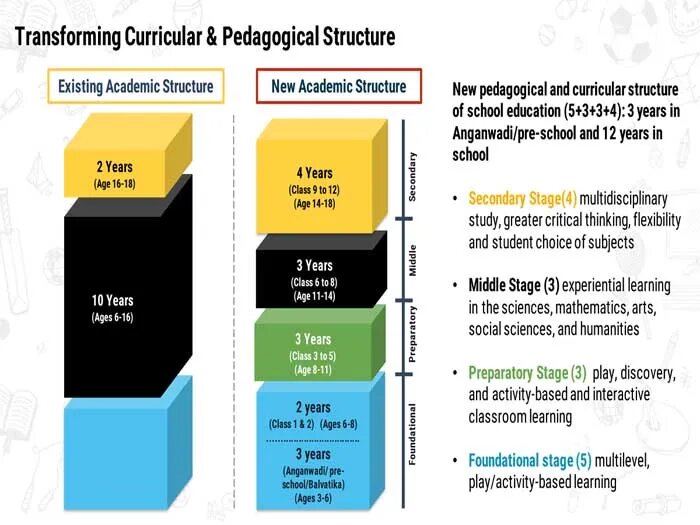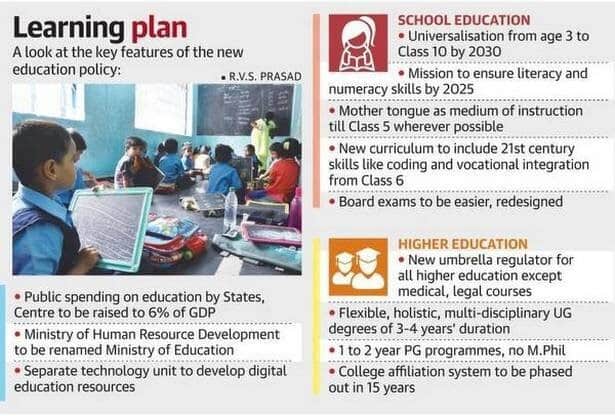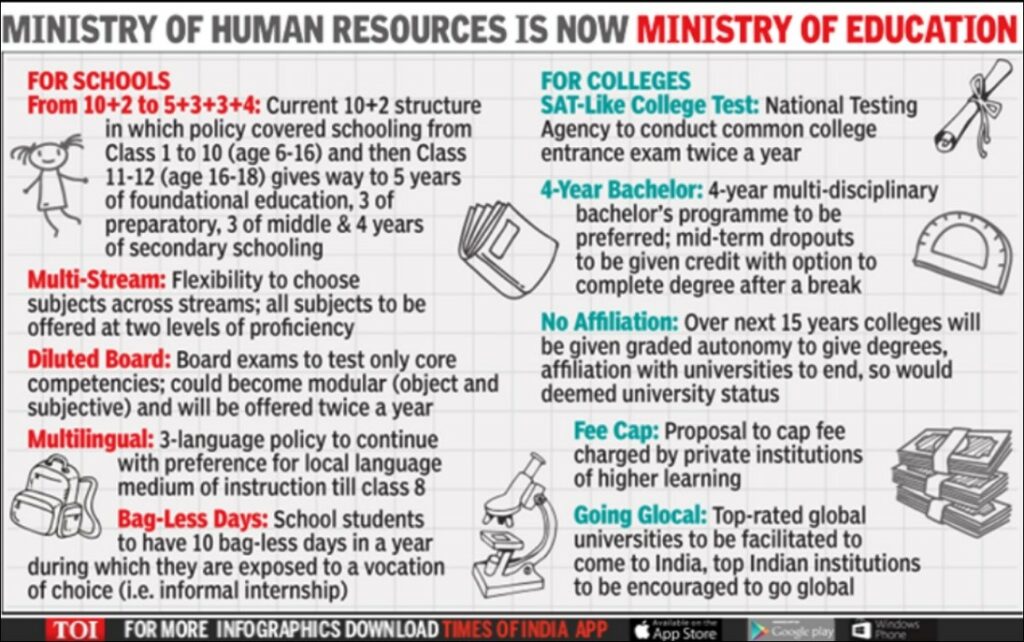The National Education Policy (NEP) 2020 was released in July 2020. This is the first education policy of the 21st century and replaces the 34-year-old National Policy on Education (NPE), 1986.
Built on the foundational pillars of Access, Equity, Quality, Affordability and Accountability, this policy is aligned to the 2030 Agenda for Sustainable Development and aims to transform India into a vibrant knowledge society and global knowledge superpower by making both school and college education more holistic, flexible, multidisciplinary, suited to 21st century needs and aimed at bringing out the unique capabilities of each student.

Objectives of NEP 2020
- Reforms in curriculum content.
- The medium of instruction should be in the local language/mother tongue of the child. The current three language formula will continue to be implemented.
- Reform in the overall assessment process
- Teacher training and management.
- Ensure effective governance of schools.
- Increasing Gross Enrolment Ratio to 50% by 2035 (It was 26.3% in 2018).
- Restructuring of institutions.
- Multidisciplinary education.
- Improving research.
- Promoting Digital education.
Key highlights of the National Education Policy 2020
Transforming School Education:
- Ensuring Universal Access at all levels of school education:
- NEP 2020 emphasizes on ensuring universal access to school education at all levels- pre-school to secondary.
- About 2 crores out of school children will be brought back into main stream under NEP 2020.
- Early Childhood Care & Education with new Curricular and Pedagogical Structure:
- With emphasis on Early Childhood Care and Education, the 10+2 structure of school curricula is to be replaced by a 5+3+3+4 curricular structure corresponding to ages 3-8, 8-11, 11-14, and 14-18 years respectively.
- This will bring the hitherto uncovered age group of 3-6 years under school curriculum, which has been recognized globally as the crucial stage for development of mental faculties of a child.
- The new system will have 12 years of schooling with three years of Anganwadi/ pre schooling.
- Attaining Foundational Literacy and Numeracy:
- Recognizing Foundational Literacy and Numeracy as an urgent and necessary prerequisite to learning, NEP 2020 calls for setting up of a National Mission on Foundational Literacy and Numeracy by MHRD.
- Reforms in school curricula and pedagogy:
- The school curricula and pedagogy will aim for holistic development of learners by equipping them with the key 21st century skills, reduction in curricular content to enhance essential learning and critical thinking and greater focus on experiential learning.
- Students will have increased flexibility and choice of subjects.
- There will be no rigid separations between arts and sciences, between curricular and extra-curricular activities, between vocational and academic streams.
- Vocational education will start in schools from the 6th grade, and will include internships.
- Multilingualism and the power of language:
- The policy has emphasized mother tongue/local language/regional language as the medium of instruction at least till Grade 5, but preferably till Grade 8 and beyond.
- Sanskrit to be offered at all levels of school and higher education as an option for students, including in the three-language formula.
- Other classical languages and literatures of India also to be available as options.
- No language will be imposed on any student.
- Equitable and Inclusive Education:
- NEP 2020 aims to ensure that no child loses any opportunity to learn and excel because of the circumstances of birth or background.
- Special emphasis will be given on Socially and Economically Disadvantaged Groups(SEDGs) which include gender, socio-cultural, and geographical identities and disabilities.
- Robust Teacher Recruitment and Career Path:
- Teachers will be recruited through robust, transparent processes.
- Promotions will be merit-based, with a mechanism for multi-source periodic performance appraisals and available progression paths to become educational administrators or teacher educators.
- A common National Professional Standards for Teachers (NPST) will be developed by the National Council for Teacher Education by 2022, in consultation with NCERT, SCERTs, teachers and expert organizations from across levels and regions.
- School Governance:
- Schools can be organized into complexes or clusters which will be the basic unit of governance and ensure availability of all resources including infrastructure, academic libraries and a strong professional teacher community.
- Standard-setting and Accreditation for School Education:
- NEP 2020 envisages clear, separate systems for policy making, regulation, operations and academic matters.
- States/UTs will set up independent State School Standards Authority (SSSA).
- Transparent public self-disclosure of all the basic regulatory information, as laid down by the SSSA, will be used extensively for public oversight and accountability.
- The SCERT will develop a School Quality Assessment and Accreditation Framework (SQAAF) through consultations with all stakeholders.

Transforming Higher Education:
- Increase GER to 50 % by 2035:
- NEP 2020 aims to increase the Gross Enrolment Ratio in higher education including vocational education from 26.3% (2018) to 50% by 2035. 3.5 Crore new seats will be added to Higher education institutions.
- Holistic Multidisciplinary Education:
- The policy envisages broad based, multi-disciplinary, holistic Under Graduate education with flexible curricula, creative combinations of subjects, integration of vocational education and multiple entry and exit points with appropriate certification.
- UG education can be of 3 or 4 years with multiple exit options and appropriate certification within this period.
- For example, Certificate after 1 year, Advanced Diploma after 2 years, Bachelor’s Degree after 3 years and Bachelor’s with Research after 4 years.
- Regulation:
- Higher Education Commission of India(HECI) will be set up as a single overarching umbrella body the for entire higher education, excluding medical and legal education.
- HECI to have four independent verticals – National Higher Education Regulatory Council (NHERC) for regulation, General Education Council (GEC) for standard setting, Higher Education Grants Council (HEGC) for funding, and National Accreditation Council (NAC) for accreditation.
- HECI will function through faceless intervention through technology, & will have powers to penalise HEIs not conforming to norms and standards.
- Public and private higher education institutions will be governed by the same set of norms for regulation, accreditation and academic standards.
- Rationalised Institutional Architecture:
- Higher education institutions will be transformed into large, well resourced, vibrant multidisciplinary institutions providing high quality teaching, research, and community engagement.
- The definition of university will allow a spectrum of institutions that range from Research-intensive Universities to Teaching-intensive Universities and Autonomous degree-granting Colleges.

Other Provisions for transformation of educational sector:
- Motivated, Energized, and Capable Faculty:
- NEP makes recommendations for motivating, energizing, and building capacity of faculty through clearly defined, independent, transparent recruitment, freedom to design curricula/pedagogy, incentivising excellence, movement into institutional leadership.
- Faculty not delivering on basic norms will be held accountable
- Teacher Education:
- A new and comprehensive National Curriculum Framework for Teacher Education, NCFTE 2021, will be formulated by the NCTE in consultation with NCERT.
- By 2030, the minimum degree qualification for teaching will be a 4-year integrated B.Ed. degree.
- Stringent action will be taken against substandard stand-alone Teacher Education Institutions (TEIs).
- Mentoring Mission:
- A National Mission for Mentoring will be established, with a large pool of outstanding senior/retired faculty – including those with the ability to teach in Indian languages – who would be willing to provide short and long-term mentoring/professional support to university/college teachers.
- Financial support for students:
- Efforts will be made to incentivize the merit of students belonging to SC, ST, OBC, and other SEDGs.
- The National Scholarship Portal will be expanded to support, foster, and track the progress of students receiving scholarships.
- Private HEIs will be encouraged to offer larger numbers of free ships and scholarships to their students.
- Professional Education:
- All professional education will be an integral part of the higher education system.
- Stand-alone technical universities, health science universities, legal and agricultural universities etc will aim to become multi-disciplinary institutions.
- Adult Education:
- Policy aims to achieve 100% youth and adult literacy.
- Financing Education:
- The Centre and the States will work together to increase the public investment in Education sector to reach 6% of GDP at the earliest.
- Open and Distance Learning:
- This will be expanded to play a significant role in increasing GER.
- Measures such as online courses and digital repositories, funding for research, improved student services, credit-based recognition of MOOCs, etc., will be taken to ensure it is at par with the highest quality in-class programmes.

Significance of National Education Policy 2020
- Recognising Importance of Formative years: In adopting a 5+3+3+4 model for school education starting at age 3, the policy recognises the primacy of the formative years from ages 3 to 8 in shaping the child’s future.
- Departure from Silos Mentality: Another key aspect of school education in the new policy is the breaking of the strict division of arts, commerce and science streams in high school. This can lay the foundation for a multi-disciplinary approach in high education.
- The Confluence of Education and Skills: Another laudable aspect of the scheme is the introduction of vocational courses with an internship. This may nudge the vulnerable sections of society to send their children to school. Also, it would help in realisation of the goal of Skill India Mission.
- Making Education More Inclusive: The NEP proposes the extension of the Right to Education (RTE) to all children up to the age of 18. Further, the policy seeks to leverage the huge potential of online pedagogy and learning methodologies for increasing gross enrolment in higher education.
- Light But Tight Oversight: According to the policy, in spite of periodic inspection, transparency, maintaining quality standards and a favourable public perception will become a 24X7 pursuit for the institutions, leading to all-round improvement in their standard. The policy also seeks to establish a super-regulator for education which will be responsible for standards-setting, funding, accreditation and regulation of higher education India.
- Allowing Foreign Universities: The document states universities from among the top 100 in the world will be able to set up campuses in India. This will lead to an infusion of international perspective and innovation, which will make the Indian education system more efficient and competitive.
- Ending Hindi vs. English Debate: Most crucially, NEP, once and for all, buries the strident Hindi versus English language debate; instead, it emphasises on making mother tongue, local language or the regional language the medium of instruction at least till Grade 5, which is considered the best medium of teaching.
Issues with the NEP- 2020
The new policy has tried to please all, and the layers are clearly visible in the document. It says all the right things and tries to cover all bases, often slipping off keel.
- Lack of integration: In both the thinking, and in the document, there are lags, such as the integration of technology and pedagogy. There are big gaps such as lifelong learning, which should have been a key element of upgrading to emerging sciences.
- Language barrier: There is much in the document ripe for debate – such as language. The NEP seeks to enable home language learning up to class five, in order to improve learning outcomes. Sure, early comprehension of concepts is better in the home language and is critical for future progress. If the foundations are not sound, learning suffers, even with the best of teaching and infrastructure. But it is also true that a core goal of education is social and economic mobility, and the language of mobility in India is English.
- Multilingualism debate: Home language succeeds in places where the ecosystem extends all the way through higher education and into employment. Without such an ecosystem in place, this may not be good enough. The NEP speaks of multilingualism and that must be emphasised. Most classes in India are de facto bilingual. Some states are blissfully considering this policy as a futile attempt to impose Hindi.
- Lack of funds: According to Economic Survey 2019-2020, the public spending (by the Centre and the State) on education was 3.1% of the GDP. A shift in the cost structure of education is inevitable. While funding at 6% of GDP remains doubtful, it is possible that parts of the transformation are achievable at a lower cost for greater scale.
- A move in haste: The country is grappled with months of COVID-induced lockdowns. The policy had to have parliamentary discussions; it should have undergone a decent parliamentary debate and deliberations considering diverse opinions.
- Overambitious: All aforesaid policy moves require enormous resources. An ambitious target of public spending at 6% of GDP has been set. This is certainly a tall order, given the current tax-to-GDP ratio and competing claims on the national exchequer of healthcare, national security and other key sectors. The exchequer itself is choked meeting the current expenditure.
- Pedagogical limitations: The document talks about flexibility, choice, experimentation. In higher education, the document recognizes that there is a diversity of pedagogical needs. If it is a mandated option within single institutions, this will be a disaster, since structuring a curriculum for a classroom that has both one-year diploma students and four-year degree students’ takes away from the identity of the institution.
- Institutional limitations: A healthy education system will comprise of a diversity of institutions, not a forced multi-disciplinarily one. Students should have a choice for different kinds of institutions. The policy risks creating a new kind of institutional isomorphism mandated from the Centre.
- Issues with examinations: Exams are neurotic experiences because of competition; the consequences of a slight slip in performance are huge in terms of opportunities. So the answer to the exam conundrum lies in the structure of opportunity. India is far from that condition. This will require a less unequal society both in terms of access to quality institutions, and income differentials consequent upon access to those institutions.
- There is a persistent mismatch between the knowledge & skills imparted and the jobs available. This has been one of the main challenges that have affected the Indian education system since Independence.
- NEP 2020 failed to check this, as it is silent on education related to emerging technological fields like artificial intelligence, cyberspace, nanotech, etc.
- An ambitious target of public spending at 6% of GDP has been set. Mobilising financial resources will be a big challenge, given the low tax-to-GDP ratio and competing claims on the national exchequer of healthcare, national security and other key sectors.
- The policy has also been criticised due to the legal complexities surrounding the applicability of two operative policies namely The Right to Education Act, 2009 and the New Education Policy, 2020. Certain provisions such as the age of starting schooling will need to be deliberated upon, in order to resolve any conundrum between the statute and the recently introduced policy in the longer run.
- It is pertinent to note that past attempts at parliamentary legislations under the erstwhile regulatory set up have not been successful. The failure can be attributed to the role of regulators and the intended legislative changes being out of alignment, as in the case of Foreign Educational Institutions (Regulation of Entry and Operations) Bill, 2010, which lapsed; and the proposed Higher Education Commission of India (Repeal of University Grants Commission Act) Act, 2018 which remained did not reach the Parliament.
- While the Universities Grants Commission and the All India Council for Technical Education have played a major role, questions pertaining to the role of the UGC and AICTE remain unanswered under the new policy.
- Doubling the Gross Enrolment Ratio in higher education by 2035 which is one of the stated goals of the policy will mean that we must open one new university every week, for the next 15 years.
- In higher education, the National Education Policy 2020’s focus on inter-disciplinary learning is a very welcome step. Universities, especially in India, have for decades been very silo-ed and departmentalized.
Measures needed for effective implementation
- This ambitious policy has a cost to be paid and the rest of the things dwells on its implementation in letter and spirit.
- Public investment is considered extremely critical for achieving the high-quality and equitable public education system as envisaged by the policy, that is truly needed for India’s future economic, social, cultural, intellectual and technological progress and growth.
- Implementation of the spirit and intent of the Policy is the most critical matter.
- It is important to implement the policy initiatives in a phased manner, as each policy point has several steps, each of which requires the previous step to be implemented successfully.
- Prioritization will be important in ensuring optimal sequencing of policy points, and that the most critical and urgent actions are taken up first, thereby enabling a strong base.
- Next, comprehensiveness in implementation will be key; as this Policy is interconnected and holistic, only a full-fledged implementation, and not a piecemeal one, will ensure that the desired objectives are achieved.
- Since education is a concurrent subject, it will need careful planning, joint monitoring, and collaborative implementation between the Centre and States.
- Timely infusion of requisite resources – human, infrastructural, and financial – at the Central and State levels will be crucial for the satisfactory execution of the Policy.
- Finally, careful analysis and review of the linkages between multiple parallel implementation steps will be necessary in order to ensure effective dovetailing of all initiatives.
- Need for Cooperative Federalism: Since education is a concurrent subject (both the Centre and the state governments can make laws on it), the reforms proposed can only be implemented collaboratively by the Centre and the states. Thus, the Centre has the giant task of building a consensus on the many ambitious plans.
- Strive Towards Universalisation of Education: There is a need for the creation of ‘inclusion funds’ to help socially and educationally disadvantaged children pursue education. Also, there is a need to set up a regulatory process that can check profiteering from education in the form of unaccounted donations.
- Bridging Digital Divide: If technology is a force-multiplier, with unequal access it can also expand the gap between the haves and have-nots. Thus, the state needs to address the striking disparities in access to digital tools for universalization of education.
- Inter-ministerial Coordination: There is an emphasis on vocational training, but to make it effective, there has to be close coordination between the education, skills and labour ministry.
Steps by the Government
- The 86th Constitution Amendment provides the Fundamental right to free and compulsory education under Article 21A includes a Common education System where the “rich and Poor are educated under one roof”.
- Rashtriya Uchchatar Shiksha Abhiyan provides funding to eligible State higher educational institutions.
- Declaration of Educational Institutions as institutions of Eminence, to provide world-class education to Indian Students within the Country.
- Creation of Higher Education Financing Agency, for high-quality infrastructure in Premier educational institutions.
- National Institution Ranking Framework for ranking our higher education institutions.
- GIAN Initiative to invite distinguished academicians, entrepreneurs, scientists, and experts from premier institutions across the world to teach in higher educational institutions in India.
- SWAYAM Portal for online Courses.
- SWAYAM Prabha Provide HD educational Channels through DTH on a 24X7 basis.
- Sodhganga to develop a national repository of universities in India, and digital Study material for higher education.
- Samagra Shiksha Scheme to ensure inclusive and equitable quality education at all levels of school education.
- The government is encouraging Open Online Courses via Swayam Platforms So that Students Can have access to quality lectures online.
- Artificial Intelligence (AI) can be used to Provide Personalised instructions based on Student needs.
- The government needs to work on improving digital infrastructure and ensure that students have access to mobile phones or laptops.
Way Forward for New Education Policy
- The New Education Policy 2020 aims to facilitate an inclusive, participatory and holistic approach, which takes into consideration field experiences, empirical research, stakeholder feedback, as well as lessons learned from best practices.
- It is a progressive shift towards a more scientific approach to education.
- The prescribed structure will help to cater the ability of the child – stages of cognitive development as well as social and physical awareness.
- If implemented in its true vision, the new structure can bring India at par with the leading countries of the world.
- The education policy should maintain a symbiotic relationship between the different regions of the country through the study of different languages.
- The quality of education provided in the country shall be such that it not only delivers basic literacy and numeracy but also creates an analytical environment in the country.
The New Education Policy-2020 represents aspirations to become a knowledge powerhouse of the world inculcating the best of the global educational experiments. The global education development agenda reflected in the Goal 4 (SDG4) of the 2030 Agenda for Sustainable Development, adopted by India in 2015 – seeks to “ensure inclusive and equitable quality education and promote lifelong learning opportunities for all” by 2030. The Education policy is a step in the right direction given it is implemented throughout the long period it targets.
